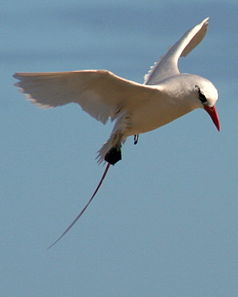Raine Island National Park
| Raine Island National Park | ||
|---|---|---|
| Red-tailed tropical bird ( Phaethon rubricauda ) | ||
|
|
||
| Location: | Queensland , Australia | |
| Specialty: | Coral island, birds | |
| Next city: | 100 mile (s) from Cape York | |
| Surface: | 40 ha | |
| Founding: | 2007 | |
| White-bellied Booby ( Sula Leucogaster ) | ||
The Raine-Iceland National Park ( English Raine Iceland National Park ) is a 131 hectares large, existing of three coral islands National Park in the Australian state of Queensland .
It is part of the Great Barrier Reef , a UNESCO World Heritage Site . The main island is named after Captain Thomas Raine , who discovered it in 1815.
location
The national park is located 620 kilometers north of Cairns and 160 kilometers southwest of Cape York on the east coast of the Cape York Peninsula . The islands are about 150 kilometers off the coast in the Coral Sea on the eastern edge of the Australian continental shelf .
The Saunders Islands National Park , Sir Charles Hardy Group National Park and Denham Group National Park are in the vicinity .
National nature
The national park includes Raine Island and the neighboring Moulter and MacLennan Cays , small coral islands. It is believed that they were formed during the last 4,700 years, as the glacier melted after the last Ice Age and the associated rise in sea levels.
Flora and fauna
The vegetation consists of grass and low shrubbery.
84 different bird species have been counted in the area of the national park, including the threatened southern Trinidad petrel ( Pterodroma heraldica ) and the endangered red-tailed tropical bird ( Phaethon rubricauda ). The largest colony of masked gannet ( Sula dactylatra ) in the Coral Sea is also at home here, as is one of the three largest white-bellied gannet colonies ( Sula Leucogaster ) in Eastern Australia.
The islands are particularly important for green turtles ( Chelonia mydas ). The animals, classified internationally as threatened, come to the island in tens of thousands during the breeding season and lay their eggs.
history
Long before the first Europeans explored the Australian seas, Torres Strait Islanders sailed from the eastern Torres Strait Islands of Murray , Darnley and Stephens to the Raine Islands using dugout canoes . The Wuthathi , a group of Aborigines from mainland Australia, also came to the islands in seaworthy outrigger canoes . Both groups maintained cultural and social contacts with one another.
The islands, reefs and surrounding waters of the outer Great Barrier Reef were used to hunt sea turtles, dive for pearls and collect trochus, a species of sea snail , and later sea cucumbers . The names of Aboriginal and Torres Strait islanders engraved on the stone tower are testimony to how far they went out to sea in their simple boats in the 19th century .
The stone tower was built by European convicts in 1844 on the orders of the British Admiralty after at least 21 ships ran aground in this area in the 18th and 19th centuries, including the HMS Pandora . Ironically, the wood of the sunken Martha Ridgeway was used for the construction of the tower. The 14 meter high tower was built from phosphorite , the limestone that occurs on the island, within four months and was intended to show the ships the way through this difficult area.
Phosphorite was mined on the island from 1890 to 1892. Chinese and Malay workers under the supervision of ten Europeans shipped tens of thousands of tons on specially built rails and a landing stage.
Web links
- Official site of the park (English)
Individual evidence
- ↑ a b Australian Government - CAPAD 2010 ( MS Excel ; 170 kB), DSEWPaC , accessed on October 7, 2012 (English)
- ↑ a b c d e f g h Raine Island National Park (Scientific) Management Statement 2006–2016 ( page no longer available , search in web archives ) Info: The link was automatically marked as defective. Please check the link according to the instructions and then remove this notice. (PDF; 398 kB), Queensland Parks and Wildlife Service , accessed on October 7, 2012 (English)
- ↑ a b c d Official Park Website - About , Queensland Parks and Wildlife Service , accessed October 7, 2012
- ↑ Official Park Website - Species List , Queensland Parks and Wildlife Service , accessed October 7, 2012
- ↑ a b c d Official Park Website - About , Queensland Parks and Wildlife Service , accessed October 7, 2012


